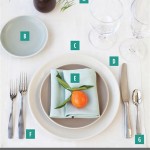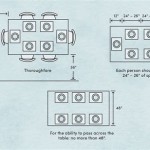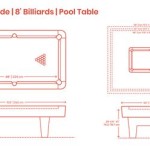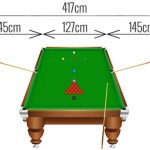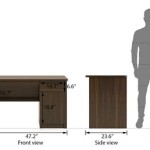```html
Painting a Dining Room Table: A Comprehensive Guide
Painting a dining room table is a cost-effective way to revitalize a central piece of furniture and update the aesthetic of a dining space. It offers an opportunity to personalize the table to match existing decor or create a completely new look. A successful paint job, however, requires careful planning, proper preparation, and the application of appropriate techniques. This article provides a comprehensive guide to painting a dining room table, detailing each step from initial assessment to final finishing.
Key Point 1: Assessing the Existing Table and Planning the Project
Before beginning the painting process, a thorough assessment of the dining room table's current condition is crucial. This assessment will inform the choice of materials, the necessary preparation steps, and the overall approach to the project. Several factors should be considered during this assessment.
Material of the Table: Identifying the material of the tabletop is the first step. Most dining room tables are made of wood, but the type of wood (e.g., solid wood, veneer, particleboard) impacts the preparation and painting process. Solid wood surfaces generally offer the greatest flexibility and durability for painting. Veneer, a thin layer of wood adhered to a substrate, requires more delicate handling to avoid damage during sanding. Particleboard, due to its porous nature, may require specialized primers and sealers to achieve a smooth, paintable surface.
Existing Finish: The existing finish on the table needs to be evaluated. Is it a clear coat, stain, varnish, lacquer, or paint? The type of existing finish will determine the necessary preparation techniques. For example, a glossy varnish may necessitate more aggressive sanding than a matte stain. Existing paint should be assessed for chipping, peeling, or cracking, as these imperfections will need to be addressed before applying a new coat.
Desired Aesthetic: The desired aesthetic of the painted table plays a significant role in planning the project. What color should the table be? Should it have a distressed or modern, smooth finish? Will a single color suffice, or will multiple colors or techniques be used? Consider the existing decor of the dining room, including wall color, flooring, and other furniture, to ensure the painted table complements the overall aesthetic. Researching different painting techniques, such as distressing, antiquing, or using stencils, can help solidify the vision for the final product.
Gathering Materials: Based on the assessment and desired aesthetic, a comprehensive list of materials needs to be compiled. This list typically includes:
- Paint: The type of paint chosen will depend on personal preference, durability requirements, and the desired aesthetic. Options include latex paint, acrylic paint, oil-based paint, and chalk paint. Latex and acrylic paints are water-based, offering easy cleanup and low VOCs (volatile organic compounds). Oil-based paints provide a durable, glossy finish but require mineral spirits for cleanup and emit higher VOCs. Chalk paint dries to a matte finish and is often used for creating a distressed or vintage look.
- Primer: Primer is essential for creating a uniform surface and ensuring proper paint adhesion, especially when painting over existing finishes or when working with porous materials like particleboard. Choose a primer that is compatible with the chosen paint type.
- Sealer/Topcoat: A sealer or topcoat protects the painted surface from scratches, stains, and wear and tear. Options include polyurethane, varnish, and wax. Polyurethane provides a durable, water-resistant finish. Varnish offers a traditional look and good protection. Wax is often used with chalk paint to create a soft, matte finish and can be buffed for added sheen.
- Sandpaper: A variety of sandpaper grits will be needed for preparing the surface, smoothing imperfections, and creating a key for paint adhesion. Common grits include 80-grit, 120-grit, 220-grit, and 320-grit.
- Tools: Essential tools include paint brushes (various sizes), paint rollers (for larger surfaces), paint trays, painter's tape, drop cloths, a scraper, a tack cloth, and safety glasses and a respirator (especially when working with oil-based paints or during sanding).
Key Point 2: Preparing the Dining Room Table for Painting
Proper preparation is the most crucial step in achieving a professional-looking paint job. Insufficient preparation can lead to poor adhesion, uneven coverage, and a finish that is prone to chipping and peeling. The preparation process typically involves cleaning, sanding, and priming the table.
Cleaning the Surface: The table surface must be thoroughly cleaned to remove dirt, grease, wax, and any other contaminants that could interfere with paint adhesion. Use a mild detergent and water solution to clean the surface, followed by a clean, damp cloth to remove any soap residue. For stubborn grease or wax, use a degreaser or mineral spirits, taking appropriate safety precautions and ensuring proper ventilation.
Sanding the Table: Sanding creates a slightly roughened surface, providing a "key" for the paint to adhere to. The extent of sanding required depends on the existing finish and the desired level of adhesion. For glossy finishes, more aggressive sanding with a coarser grit (e.g., 80-grit or 120-grit) is necessary to dull the surface. For smoother finishes, light sanding with a finer grit (e.g., 220-grit) may suffice. When sanding veneer, exercise caution to avoid sanding through the thin layer of wood. Always sand in the direction of the grain of the wood to avoid creating scratches that are visible through the paint. After sanding, thoroughly remove all sanding dust with a tack cloth or a vacuum cleaner with a brush attachment. A tack cloth is a specifically treated cloth that effectively picks up fine dust particles.
Addressing Imperfections: Before priming, inspect the table surface for any imperfections, such as cracks, dents, or holes. Fill these imperfections with wood filler or epoxy putty, following the manufacturer's instructions. Allow the filler to dry completely, and then sand it smooth to blend with the surrounding surface. If there are deeper gouges or significant damage, consider consulting with a professional furniture restorer.
Priming the Table: Primer provides a uniform surface for the paint to adhere to, seals porous materials, and blocks stains from bleeding through the paint. Choose a primer that is compatible with the chosen paint type and the type of wood. Apply the primer in thin, even coats, following the manufacturer's instructions. Allow the primer to dry completely before proceeding to the next step. One or two coats of primer may be necessary, depending on the porosity of the surface and the degree of color coverage required. Lightly sand the primed surface with a fine-grit sandpaper (e.g., 320-grit) to remove any imperfections or brushstrokes before applying the paint.
Taping Off Areas: Use painter's tape to mask off any areas that should not be painted, such as legs, edges, or decorative elements. Apply the tape firmly and ensure that it is properly sealed to prevent paint from bleeding underneath. Remove the tape carefully after the paint has dried, but before it has fully cured, to avoid pulling off any paint.
Key Point 3: Applying the Paint and Finishing Touches
Once the table has been properly prepared, the paint can be applied. The application technique will influence the final appearance of the table. After painting, applying a protective topcoat will preserve the work and enhance the table's durability.
Applying the Paint: Apply the paint in thin, even coats, using a high-quality brush or roller. Avoid applying too much paint at once, as this can lead to drips, runs, and an uneven finish. For large surfaces, a roller can provide more efficient coverage. For smaller areas and intricate details, use a brush. Several thin coats are preferable to one thick coat. Allow each coat of paint to dry completely before applying the next. Lightly sand between coats with a fine-grit sandpaper (e.g., 320-grit) to remove any imperfections or brushstrokes. The number of coats required will depend on the color and opacity of the paint, as well as the desired level of coverage. Aim for a smooth, uniform finish.
Distressing Techniques (Optional): If a distressed or antique look is desired, various techniques can be used after the paint has dried. These techniques include:
- Sanding: Use sandpaper to remove paint from edges, corners, and other areas that would naturally wear over time.
- Dry Brushing: Apply a small amount of paint to a dry brush and lightly brush it over the surface, leaving some of the base coat visible.
- Glazing: Apply a thin layer of glaze over the paint and then wipe it off with a cloth, leaving glaze in the crevices and details.
Experiment with different techniques to achieve the desired level of distressing. Remember to apply a topcoat to protect the distressed finish.
Applying the Topcoat: A topcoat protects the painted surface from scratches, stains, and wear and tear. Choose a topcoat that is compatible with the chosen paint type and the desired level of sheen. Polyurethane is a popular choice for dining room tables due to its durability and water resistance. Apply the topcoat in thin, even coats, following the manufacturer's instructions. Allow each coat to dry completely before applying the next. Lightly sand between coats with a fine-grit sandpaper (e.g., 320-grit) to remove any imperfections or brushstrokes. Two or three coats of topcoat are typically recommended for optimal protection.
Curing Time: Allow the paint and topcoat to fully cure before using the dining room table. Curing time can vary depending on the type of paint and topcoat used, as well as the ambient temperature and humidity. Refer to the manufacturer's instructions for specific curing times. Avoid placing heavy objects on the table during the curing process.
Final Inspection and Touch-Ups: After the paint and topcoat have fully cured, conduct a final inspection of the table. Touch up any imperfections or areas that require additional coverage. Remove any remaining painter's tape carefully. Clean the table with a mild detergent and water solution.
Painting a dining room table is a rewarding project that can transform the look of a dining space. By carefully planning the project, preparing the surface properly, and applying the paint and topcoat with attention to detail, a professional-looking finish can be achieved. The result is a revitalized piece of furniture that enhances the aesthetic of the dining room for years to come.
```
The Best Way To Paint A Dining Table And Chairs Confessions Of Serial Do It Yourselfer
Tips For Painting A Dining Room Table Beautiful Mess

Dining Table Makeover Don T Buy New Furniture Prettydistressed

Antique Dining Table Updated With Chalk Paint Anderson Grant

Painting Kitchen Tables S Ideas Tips From

The Best Way To Paint A Dining Table And Chairs Confessions Of Serial Do It Yourselfer

Our Painted Dining Room Table The Wicker House
How To Spray Paint Dining Chairs Refresh Restyle

Painting A Kitchen Table Centsational Style

Painting A Dining Room Set With Chalk Paint The Purple Painted Lady


